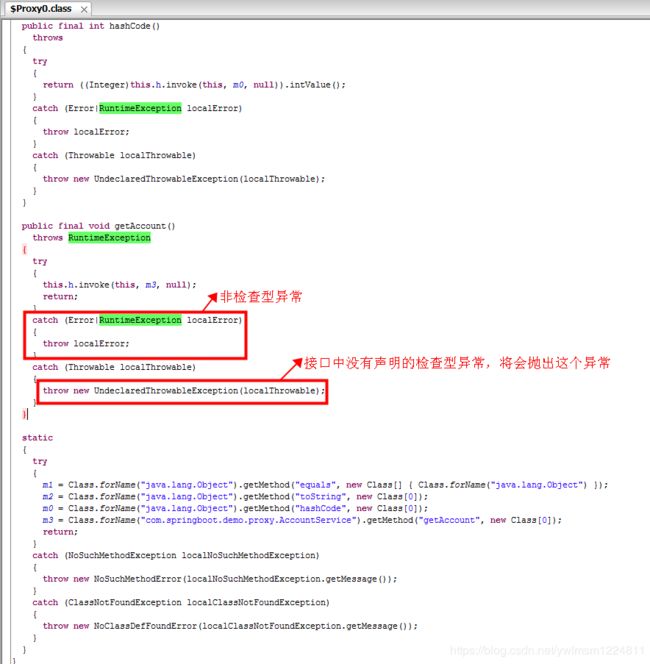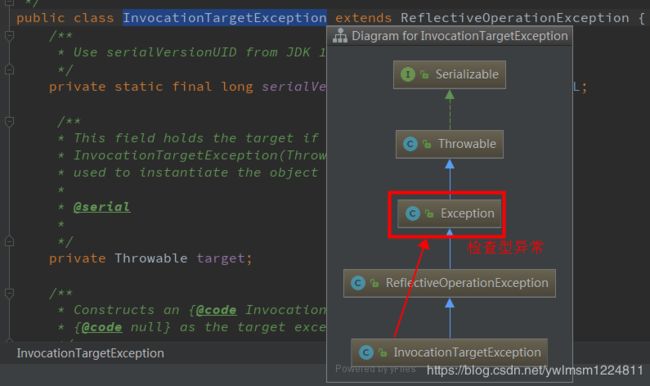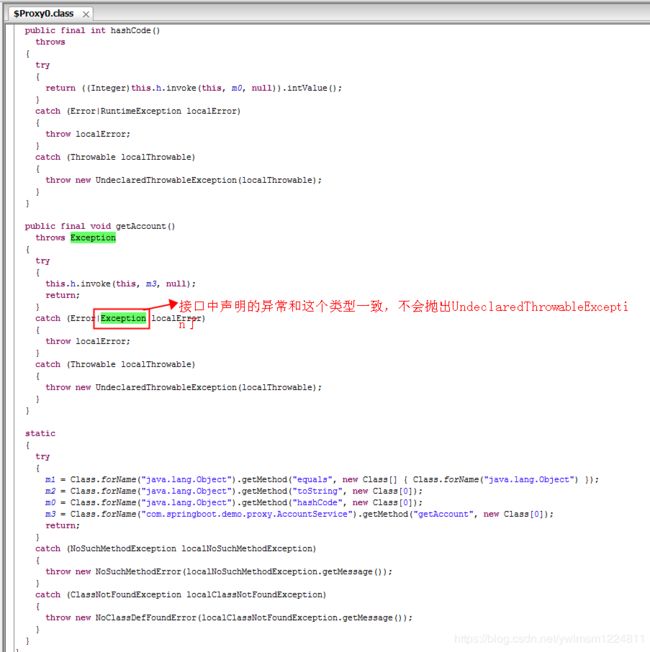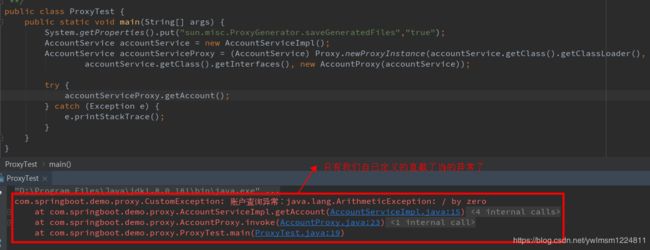JDK动态代理UndeclaredThrowableException异常
UndeclaredThrowableException异常背景
最近项目上出现了 JDK动态代理UndeclaredThrowableException异常,此异常之前没有接触过,那么该异常将会导致什么呢?
UndeclaredThrowableException后果:导致该抛出的直接异常信息被包装了好几层,异常看起来很费事,如下图:
产生原因
要了解其原因的前提条件是必须了解检查型异常和非检查型异常,了解的话请查看这个链接:检查型异常和非检查型异常
为什么会产生UndeclaredThrowableException异常呢?通过查阅javadoc官方文档(链接地址:https://docs.oracle.com/javase/6/docs/api/java/lang/reflect/InvocationHandler.html),发现了该异常抛出的条件,如下图:
上述原因翻译成关键一句就是:如果抛出的异常是检查型异常,而代理类在处理异常时没有发现该类型的异常在接口中声明
这种话是什么意思呢?下面结合代码给大家讲述一下,动态代理之后会生成$Proxy0.class文件,至于怎么生成并查看这个文件,请查看这个链接:JDK动态代理文件$Proxy0.class的生成和查看, $Proxy0.class 文件内容说明了如何抛出了UndeclaredThrowableException异常,如下图:
通过JDK动态代理代码调用我们发现,method.invoke(target, args) 将会抛出 InvocationTargetException ,InvocationTargetException 异常属于检查型异常,如下图:
而代码中接口声明的是非检查型异常RuntimeException,因此会抛出 UndeclaredThrowableException异常,示例demo如下所示:
// 自定义异常
public class CustomException extends RuntimeException {
private static final long serialVersionUID = -5427543428947291283L;
public CustomException(String message) {
super(message);
}
}
// 接口
public interface AccountService {
void getAccount() throws RuntimeException;
}
// 实现类
public class AccountServiceImpl implements AccountService {
@Override
public void getAccount() throws RuntimeException {
try {
System.out.println(1/0);
} catch (Exception e) {
throw new CustomException("账户查询异常:" + e);
}
}
}
// JDK动态代理类
public class AccountProxy implements InvocationHandler {
private Object target;
public AccountProxy(Object target) {
this.target = target;
}
@Override
public Object invoke(Object proxy, Method method, Object[] args) throws Throwable {
return method.invoke(target, args);
}
}
// 测试类
public class ProxyTest {
public static void main(String[] args) {
System.getProperties().put("sun.misc.ProxyGenerator.saveGeneratedFiles","true");
AccountService accountService = new AccountServiceImpl();
AccountService accountServiceProxy = (AccountService) Proxy.newProxyInstance(accountService.getClass().getClassLoader(),
accountService.getClass().getInterfaces(), new AccountProxy(accountService));
try {
accountServiceProxy.getAccount();
} catch (Exception e) {
e.printStackTrace();
}
}
}避免抛出 UndeclaredThrowableException异常
那么针对上述代码,我们怎么样避免UndeclaredThrowableException异常的抛出呢?我们既然知道了该异常的抛出原因,那么只需要简单修改一下就可以避免此异常的抛出,即只需要将接口中抛出的异常修改为检查型异常即可,如下所示:
// 接口中的 RuntimeException 修改为了 Exception
public interface AccountService {
void getAccount() throws Exception;
}代理类 $Proxy0.class 如下图所示:
注意: 这里的异常类型和你自定义异常的类型无关吗,只和代理类接口中声明的异常类型有关
完美的解决方案
我们不管代理接口中声明的抛出类型是什么,我们只想看到自己抛出的直接的异常,UndeclaredThrowableException异常 和 InvocationTargetException 异常都不想看到,这样更容易定位到问题。解决方案就是在 method.invoke(target, args) 进行 InvocationTargetException 异常的捕获,代码如下:
// method.invoke(target, args) 方法调用地方增加了 InvocationTargetException 异常的捕获
public class AccountProxy implements InvocationHandler {
private Object target;
public AccountProxy(Object target) {
this.target = target;
}
@Override
public Object invoke(Object proxy, Method method, Object[] args) throws Throwable {
try {
return method.invoke(target, args);
} catch (InvocationTargetException e) {
throw e.getCause();
}
}
}运行结果如下图所示:
总结
通过上述分析可知,当我们使用JDK动态代理的时候,需要捕获 method.invoke(target, args) 抛出的 InvocationTargetException 异常
代理类中为什么对未声明的检查型异常转换为 UndeclaredThrowableException 异常呢?答案是 java 继承原则,即子类覆盖父类方法或者实现父类方法时,抛出的异常必须在父类支持的异常列表之内。





